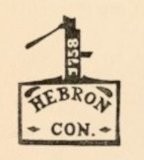
The Hebron Historical Society
Hebron, Connecticut
Enjoy Hebron - It's Here To Stay ™

The story of the Ams Mansion has captured the imagination of many. Perhaps it is because its famous owner, Charles M. Ams, who failed to deliver manufacturing fame for Hebron, died May 25, 1930, only six months before the home was completed. Perhaps it is because Ams' wife, Amalia Elizabeth, died less than a month after her husband on June 21. Despite the fact that neither of the original owners ever lived in it, the mansion soon became the headquarters of a different vision and legacy of the Ams family.
John Sibun, in his 1975 book, Our Town's Heritage: 1708-1958, Hebron, Connecticut, reflected on the Ams Mansion: "To this day, it is impressively the largest house in town." At 5,272 square feet for the main house alone, it still holds this distinction in 2005.
The story really begins with Phineas W. Turner. Turner had been buying up the land on the south side of Hebron since the mid 1850's, and building a number of mills and factories. A post office was established, with P. W. serving as Postmaster. Even though Turner died in 1903 and his famous silk mills were defunct a few years later, the area was universally referred to as "Turnerville."
In a town that still refers to properties by the name of the original owner, that is tradition.
Charles Ams began his land-buying spree in 1912, almost ten years after Turner's death. It is a common misnomer that Charles Ams bought the Turner lands in Amston directly from Turner and his wife, Catherine. Land records in the Hebron Town Clerk's office reveal that Ams actually purchased the Turner lands and water rights from Israel Eisenstein and Daniel Brown on December 4, 1912. He also purchased adjoining tracts of land in areas that were technically Colchester and Lebanon; the transactions are recorded in the land records of those towns.
It didn't take long for Ams to start posting notices regarding "his" property. The collection of Paul Pomprowicz includes a notice in which Ams warned people "No hunting, no trespassing." basically "No Nothing" and signed it "Supt. Chas. M. Ams, Owner." But notice the linen poster states that the village name is "Turnerville, Conn." It appears from this artifact that Charles Ams wanted to quickly establish his authority in the south end of Hebron. Sometime in 1913, the village name, as well as the post office name, was changed to "Amston."